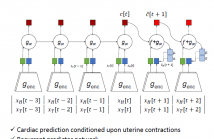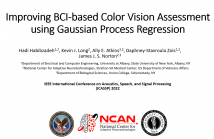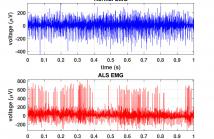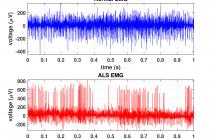
- Read more about Parametric Modeling of Human Wrist for Bioimpedance-based Physiological Sensing
- Log in to post comments
Bioimpedance is a powerful modality to continuously and non-invasively monitor cardiovascular and respiratory health parameters through the wearable operation. However, for bioimpedance sensors to be utilized in medical-grade settings, the reliability and robustness of the system should be improved. Previous studies provide limited fundamental analyses of the factors involved in the system that impact the sensitivity and the specificity of the modality in capturing the hemodynamics.
- Categories:
 16 Views
16 Views
- Read more about Contrastive Predictive Coding for anomaly detection of fetal health from the cardiotocogram
- Log in to post comments
Fetal well-being during labor is currently assessed by medical professionals through visual interpretation of the cardiotocogram (CTG), a simultaneous recording of Fetal Heart Rate (FHR) and Uterine Contractions (UC). This method is disputed due to high inter- and intra-observer variability and a resulting increase in the number of unnecessary interventions. A method for computerized interpretation of the CTG, based on Contrastive Predictive Coding (CPC) is presented here.
- Categories:
 20 Views
20 Views
- Read more about Habibzadeh_ICASSP3270_poster
- Log in to post comments
We present metamer identification plus (metaID+), an algorithm that enhances the performance of brain-computer interface (BCI)-based color vision assessment. BCI-based color vision assessment uses steady-state visual evoked potentials (SSVEPs) elicited during a grid search of colors to identify metamers—light sources with different spectral distributions that appear to be the same color. Present BCI-based color vision assessment methods are slow; they require extensive data collection for each color in the grid search to reduce measurement noise.
- Categories:
 12 Views
12 Views
- Read more about ALSNET: A DILATED 1-D CNN FOR IDENTIFYING ALS FROM RAW EMG SIGNAL (Presentation Slides)
- Log in to post comments
Amyotrophic Lateral Sclerosis (ALS) is one of the most common neuromuscular diseases which affects both lower and upper motor neurons. In this paper, a dilated one dimensional convolutional neural network, named ALSNet, is proposed for identifying ALS from raw EMG signal. No hand-crafted feature extraction is required, rather, ALSNet is able to take raw EMG signal as input and detect EMG signals of ALS subjects. This makes the method more feasible for practical implementation by reducing the computational cost required for extracting features.
- Categories:
 509 Views
509 Views
- Read more about ALSNET: A DILATED 1-D CNN FOR IDENTIFYING ALS FROM RAW EMG SIGNAL (Poster)
- Log in to post comments
Amyotrophic Lateral Sclerosis (ALS) is one of the most common neuromuscular diseases which affects both lower and upper motor neurons. In this paper, a dilated one dimensional convolutional neural network, named ALSNet, is proposed for identifying ALS from raw EMG signal. No hand-crafted feature extraction is required, rather, ALSNet is able to take raw EMG signal as input and detect EMG signals of ALS subjects. This makes the method more feasible for practical implementation by reducing the computational cost required for extracting features.
- Categories:
 19 Views
19 Views
- Read more about PRELIMINARY RESULTS ON THE GENERATION OF ARTIFICIAL HANDWRITING DATA USING A DECOMPOSITION-RECOMBINATION STRATEGY
- Log in to post comments
- Categories:
 5 Views
5 Views
- Read more about A Novel Unsupervised Autoencoder-based HFOs Detector in Intracranial EEG Signals
- Log in to post comments
- Categories:
 7 Views
7 Views
- Read more about Learning to Correct Axial Motion in OCT For 3D Retinal Imaging
- Log in to post comments
Optical Coherence Tomography (OCT) is a powerful technique for non-invasive 3D imaging of biological tissues at high resolution that has revolutionized retinal imaging. A major challenge in OCT imaging is the motion artifacts introduced by involuntary eye movements. In this paper, we propose a convolutional neural network that learns to correct axial motion in OCT based on a single volumetric scan. The proposed method is able to correct large motion, while preserving the overall curvature of the retina.
- Categories:
 42 Views
42 Views